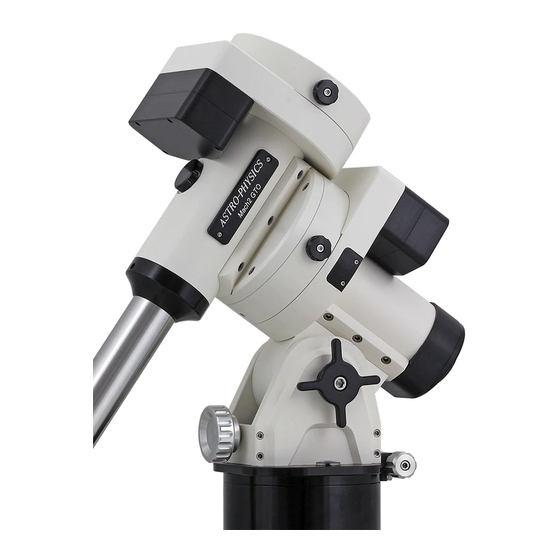ASTRO-PHYSICS 900 German Equatorial Руководство - Страница 11
Просмотреть онлайн или скачать pdf Руководство для Аксессуары ASTRO-PHYSICS 900 German Equatorial. ASTRO-PHYSICS 900 German Equatorial 12 страниц. Polar alignment telescope and illuminator (pasill)
Также для ASTRO-PHYSICS 900 German Equatorial: Краткое руководство по эксплуатации (2 страниц), Руководство (3 страниц)

extinguish at the end of the recording period. During this 6.5-minute period it will be necessary to keep the star
on the crosshair. Every button input will be recorded. Avoid trying to guide out any atmospheric scintillation,
since this will add a random noise error into your final guide rate. If an ST4 autoguider is available, it can be
used to guide, and the controller will faithfully remember each error correction that it makes. An autoguider is
extremely accurate, and will place into the memory a very smooth correction of the gear error.
When you wish to play back the recorded corrections, slide the play/record switch into the "play" mode. The
controller will automatically play back the correct portion of the worm error. It is not necessary to place the rate
switched into the same position that they were recorded in. For the smoothest results, however, it is advised
to record and play back in the .25x position. The controller can be slewed in the 8x and 16x mode at any time
without losing track of the periodic error. The playback can also be turned on and off at any time without losing
track of the gear position.
A most valuable feature of this circuit is that it automatically compensates for any drift inadvertently introduced
by the operator in the process of recording the gear error. For instance, if the mount was not properly polar
aligned in altitude, the right ascension drift rate would be in error. The circuitry automatically subtracts this
slow drift from the memory, so that the overall long-term drive rate remains exactly at the King rate. This way
the compensated driving rate will always be correct for any other position in the sky and for any other time that
the mount is set up in the field. When the mount is properly polar aligned, it is possible to take 15 to 30 minute
unguided astrophotos without trailed star images. For more critical exposures, the controller memory allows
the astrophotographer to check the guide star only occasionally during a long exposure.
LED KNOB: There is an LED output available on the 900 Dec. axis motor housing as shown in the diagram on page 2.
You may insert your LED reticle to this plug. Brightness can then be controlled using the MIN to MAX
(minimum to maximum) setting of the LED knob.
AUTOGUIDER CONNECTION: If you own a Santa Barbara Instrument Group (SBIG) ST-4 or ST-6 Star Tracker/Imaging
system, connect it to the RJ11 phono plug input of the controller via a TIC (Tracking Interface Cable) produced
by SBIG. You may purchase the cable directly from us (our part #CABTIC) or directly from SBIG. This cable
will have a DB15 female connector on one end and an RJ11 plug on the end that inserts into our controller.
To operate the SBIG ST-7 or ST-8, you will need the ST-7 cable available from SBIG. This is the same cable
that is offered for the Celestron Ultima. It has a DB9 male connector on one end and an RJ11 connector that
inserts into our controller.
GUIDING YOUR ASTROPHOTOS
The natural tendency of astrophotographers is to push the directional button of the controller in the direction he or she
wants the guide star to move until the star has centered itself in the guiding reticle. This method often results in
overshooting the center of the reticle since the reaction time to let go of the button is often too late. By the time the
gears in the drive motor have reversed and are driving again at the normal guiding rate, the star has moved past the
center of the reticle. Then the opposite button is pushed to move the guide star back in the opposite direction toward
the center and the same overshooting may occur.
The proper way to guide (and this will apply to almost any commercially available mounting) is to pulse your correction,
much like the SBIG ST-4 does in its auto-guiding operation. Pulse the button for only a fraction of a second and note
the new position of the guide star. If it has not moved far enough, pulse it again. Normally, it takes only one or two
pulses to re-center the star. Declination drift can be eliminated by proper polar alignment. Fine adjustment can be
made by noting the direction of Dec. drift, and, using the azimuth adjusting screws, move the star in the opposite
direction. Several of these iterations can be made until the Dec. drift is in the opposite direction. R.A. drift will occur if
the polar altitude is set wrong. If the drive rate seems to be too fast (star drifts eastward), the altitude is set too low.
Adjust it upwards until the R.A. drift stops or reverses. Both altitude and azimuth will affect each drift rate, so some
back and forth adjustment may be necessary.
Proceed to next page for Mount Maintenance and Alignment
- 11 -
